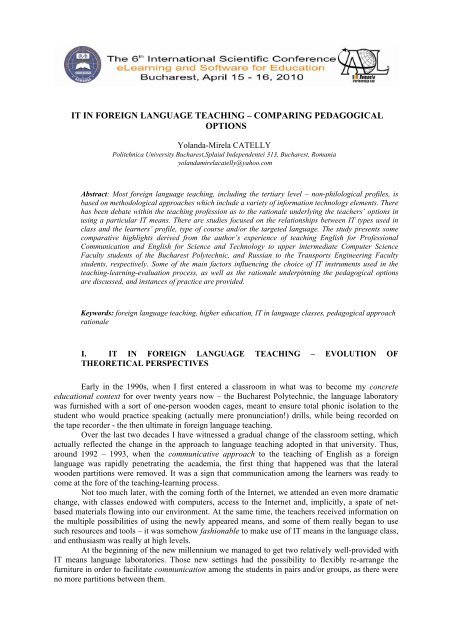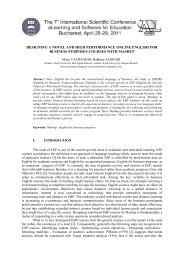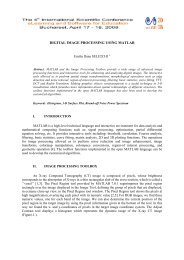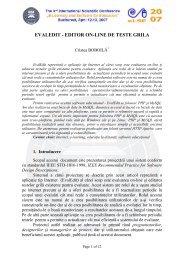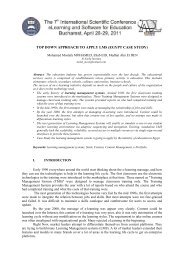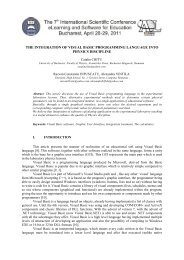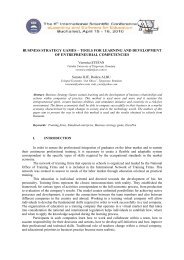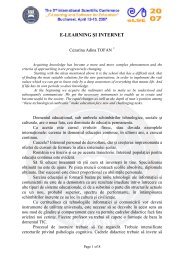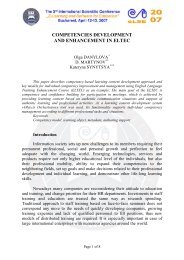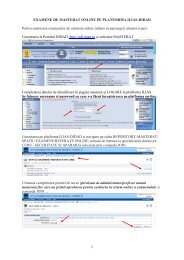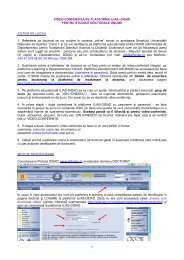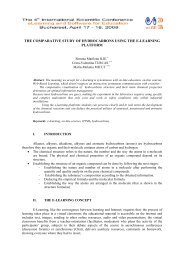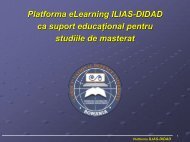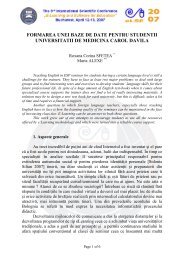it in foreign language teaching â comparing pedagogical options
it in foreign language teaching â comparing pedagogical options
it in foreign language teaching â comparing pedagogical options
You also want an ePaper? Increase the reach of your titles
YUMPU automatically turns print PDFs into web optimized ePapers that Google loves.
IT IN FOREIGN LANGUAGE TEACHING – COMPARING PEDAGOGICAL<br />
OPTIONS<br />
Yolanda-Mirela CATELLY<br />
Pol<strong>it</strong>ehnica Univers<strong>it</strong>y Bucharest,Splaiul Independentei 313, Bucharest, Romania<br />
yolandamirelacatelly@yahoo.com<br />
Abstract: Most <strong>foreign</strong> <strong>language</strong> teach<strong>in</strong>g, <strong>in</strong>clud<strong>in</strong>g the tertiary level – non-philological profiles, is<br />
based on methodological approaches which <strong>in</strong>clude a variety of <strong>in</strong>formation technology elements. There<br />
has been debate w<strong>it</strong>h<strong>in</strong> the teach<strong>in</strong>g profession as to the rationale underly<strong>in</strong>g the teachers’ <strong>options</strong> <strong>in</strong><br />
us<strong>in</strong>g a particular IT means. There are studies focused on the relationships between IT types used <strong>in</strong><br />
class and the learners’ profile, type of course and/or the targeted <strong>language</strong>. The study presents some<br />
comparative highlights derived from the author’s experience of teach<strong>in</strong>g English for Professional<br />
Communication and English for Science and Technology to upper <strong>in</strong>termediate Computer Science<br />
Faculty students of the Bucharest Polytechnic, and Russian to the Transports Eng<strong>in</strong>eer<strong>in</strong>g Faculty<br />
students, respectively. Some of the ma<strong>in</strong> factors <strong>in</strong>fluenc<strong>in</strong>g the choice of IT <strong>in</strong>struments used <strong>in</strong> the<br />
teach<strong>in</strong>g-learn<strong>in</strong>g-evaluation process, as well as the rationale underp<strong>in</strong>n<strong>in</strong>g the <strong>pedagogical</strong> <strong>options</strong><br />
are discussed, and <strong>in</strong>stances of practice are provided.<br />
Keywords: <strong>foreign</strong> <strong>language</strong> teach<strong>in</strong>g, higher education, IT <strong>in</strong> <strong>language</strong> classes, <strong>pedagogical</strong> approach<br />
rationale<br />
I. IT IN FOREIGN LANGUAGE TEACHING – EVOLUTION OF<br />
THEORETICAL PERSPECTIVES<br />
Early <strong>in</strong> the 1990s, when I first entered a classroom <strong>in</strong> what was to become my concrete<br />
educational context for over twenty years now – the Bucharest Polytechnic, the <strong>language</strong> laboratory<br />
was furnished w<strong>it</strong>h a sort of one-person wooden cages, meant to ensure total phonic isolation to the<br />
student who would practice speak<strong>in</strong>g (actually mere pronunciation!) drills, while be<strong>in</strong>g recorded on<br />
the tape recorder - the then ultimate <strong>in</strong> <strong>foreign</strong> <strong>language</strong> teach<strong>in</strong>g.<br />
Over the last two decades I have w<strong>it</strong>nessed a gradual change of the classroom sett<strong>in</strong>g, which<br />
actually reflected the change <strong>in</strong> the approach to <strong>language</strong> teach<strong>in</strong>g adopted <strong>in</strong> that univers<strong>it</strong>y. Thus,<br />
around 1992 – 1993, when the communicative approach to the teach<strong>in</strong>g of English as a <strong>foreign</strong><br />
<strong>language</strong> was rapidly penetrat<strong>in</strong>g the academia, the first th<strong>in</strong>g that happened was that the lateral<br />
wooden part<strong>it</strong>ions were removed. It was a sign that communication among the learners was ready to<br />
come at the fore of the teach<strong>in</strong>g-learn<strong>in</strong>g process.<br />
Not too much later, w<strong>it</strong>h the com<strong>in</strong>g forth of the Internet, we attended an even more dramatic<br />
change, w<strong>it</strong>h classes endowed w<strong>it</strong>h computers, access to the Internet and, implic<strong>it</strong>ly, a spate of netbased<br />
materials flow<strong>in</strong>g <strong>in</strong>to our environment. At the same time, the teachers received <strong>in</strong>formation on<br />
the multiple possibil<strong>it</strong>ies of us<strong>in</strong>g the newly appeared means, and some of them really began to use<br />
such resources and tools – <strong>it</strong> was somehow fashionable to make use of IT means <strong>in</strong> the <strong>language</strong> class,<br />
and enthusiasm was really at high levels.<br />
At the beg<strong>in</strong>n<strong>in</strong>g of the new millennium we managed to get two relatively well-provided w<strong>it</strong>h<br />
IT means <strong>language</strong> laboratories. Those new sett<strong>in</strong>gs had the possibil<strong>it</strong>y to flexibly re-arrange the<br />
furn<strong>it</strong>ure <strong>in</strong> order to facil<strong>it</strong>ate communication among the students <strong>in</strong> pairs and/or groups, as there were<br />
no more part<strong>it</strong>ions between them.
However, <strong>it</strong> may be <strong>in</strong>terest<strong>in</strong>g to note that rudiments of the old, so-called trad<strong>it</strong>ional teach<strong>in</strong>g<br />
approach, were still visible, as on each desk there were (and still are, although they are no longer<br />
really used <strong>in</strong> teach<strong>in</strong>g) headphones for the students to listen to the lesson <strong>in</strong>put under the best possible<br />
technical circumstances. That nobody actually makes use of them dur<strong>in</strong>g the <strong>language</strong> classes<br />
nowadays is obvious, as the ma<strong>in</strong> focus of the <strong>language</strong> course is to develop the communicative<br />
competence of the students by expos<strong>in</strong>g them to authentic <strong>in</strong>put, <strong>in</strong> authentic cond<strong>it</strong>ions, which qu<strong>it</strong>e<br />
often means background noise, <strong>in</strong>stabil<strong>it</strong>y of the source etc. (that is why listen<strong>in</strong>g to the loud speakers<br />
mounted <strong>in</strong> the classroom walls is preferred) and to expose them to authentic tasks simulat<strong>in</strong>g as<br />
closely as possible the real world <strong>in</strong> which they are expected to perform.<br />
It is <strong>in</strong>terest<strong>in</strong>g to note that, w<strong>it</strong>h the emergence of the new IT technologies, like most teachers<br />
of <strong>foreign</strong> <strong>language</strong>s, those of us who have embarked upon <strong>in</strong>tegrat<strong>in</strong>g these new means <strong>in</strong>to the<br />
<strong>language</strong> class actually passed through the three stages mentioned by [3], i.e. acceptance, then<br />
frustration and f<strong>in</strong>ally the honey moon phase.<br />
These stages are, we believe, <strong>in</strong>herent to a teacher who first discovers a mult<strong>it</strong>ude of<br />
possibil<strong>it</strong>ies <strong>in</strong> the newly emerged technical tools, then they notice that perhaps this new world is a<br />
touch too vast to be easily grasped – mostly from the technical po<strong>in</strong>t of view, at that stage – to f<strong>in</strong>ally<br />
enthusiastically accept<strong>in</strong>g <strong>it</strong>, once the technical difficulties encountered <strong>in</strong> handl<strong>in</strong>g them have been<br />
resolved.<br />
The stage we are at present goes one step beyond the honey moon of the beg<strong>in</strong>n<strong>in</strong>gs – as, <strong>in</strong><br />
time, we have noticed that, as w<strong>it</strong>h so many <strong>in</strong>terest<strong>in</strong>g tools (of the type of games, music, video etc.)<br />
there is a major risk that their <strong>in</strong>troduction and permanent use <strong>in</strong> class can be conducive to a decrease<br />
of the qual<strong>it</strong>y of the teach<strong>in</strong>g–learn<strong>in</strong>g process, for various reasons that will be discussed <strong>in</strong> this study.<br />
What we ma<strong>in</strong>ta<strong>in</strong> here is that <strong>in</strong> us<strong>in</strong>g IT <strong>in</strong> class, <strong>foreign</strong> <strong>language</strong> teachers should start by<br />
adopt<strong>in</strong>g a reflexive att<strong>it</strong>ude. They should analyze the repertoire of tools available and choose only<br />
those ones that would really help their students, whose needs, profile and level must be taken <strong>in</strong>to<br />
account.<br />
They should <strong>in</strong>tegrate the new technologies <strong>in</strong>to the trad<strong>it</strong>ional class <strong>in</strong> a well justified manner<br />
from the <strong>pedagogical</strong> po<strong>in</strong>t of view, w<strong>it</strong>hout exaggerations, viz. w<strong>it</strong>hout turn<strong>in</strong>g the use <strong>in</strong>to abuse, as<br />
such an option would certa<strong>in</strong>ly endanger the qual<strong>it</strong>y and efficiency of the <strong>language</strong> class. Bas<strong>in</strong>g one’s<br />
us<strong>in</strong>g of IT means on a sound <strong>pedagogical</strong> rationale, as well as mak<strong>in</strong>g the right <strong>options</strong> <strong>in</strong> decid<strong>in</strong>g<br />
upon the weight<strong>in</strong>g and variety of IT tools, is what we are ma<strong>in</strong>ly try<strong>in</strong>g to advocate <strong>in</strong> this study.<br />
The l<strong>it</strong>erature available on the relationship between the teach<strong>in</strong>g of <strong>foreign</strong> <strong>language</strong>s and the<br />
implementation of IT means <strong>in</strong> the didactic process is ma<strong>in</strong>ly focused on display<strong>in</strong>g the vast<br />
possibil<strong>it</strong>ies which have been created lately. Thus, there are numerous s<strong>it</strong>es for this purpose, as well as<br />
onl<strong>in</strong>e journals - see, for example [1, 2, 3, 9, 13]. Unfortunately, very few actually warn the <strong>language</strong><br />
teachers about the possible risks they might run <strong>in</strong> us<strong>in</strong>g such implements w<strong>it</strong>hout deep consideration<br />
of the lesson aims focused on the learners’ needs.<br />
That there are numerous advantages <strong>in</strong> us<strong>in</strong>g the Internet, for <strong>in</strong>stance, is also a matter of<br />
common knowledge. There are authors who stress on the various benef<strong>it</strong>s of us<strong>in</strong>g the net <strong>in</strong> the<br />
<strong>language</strong> class. Fidelman [9] shows some of the most relevant, as follows:<br />
- the World Wide Web is a good source of visually rich, <strong>in</strong>teractive and <strong>in</strong>stantaneous<br />
<strong>in</strong>formation to people all over the globe;<br />
- l<strong>in</strong>ks to (isolated) people are provided, as well as ideas of other cultures;<br />
- even people <strong>in</strong> the <strong>language</strong> teach<strong>in</strong>g and research fields who are not very skilled<br />
technically can get <strong>in</strong>formation via <strong>it</strong>, as <strong>it</strong> is very user-friendly.<br />
At the same time, the author underl<strong>in</strong>es that this is also a challenge to educational<br />
professionals, who should try to understand how their field can be improved qual<strong>it</strong>atively by what she<br />
calls the wise use of the Internet and the World Wide Web.<br />
Another author [3] also refers to the pluses she envisages <strong>in</strong> us<strong>in</strong>g the WWW <strong>in</strong> the <strong>language</strong><br />
class, which are:<br />
- provid<strong>in</strong>g the students w<strong>it</strong>h authentic <strong>language</strong>,<br />
- ensur<strong>in</strong>g up-to-the-m<strong>in</strong>ute <strong>in</strong>formation,<br />
- creat<strong>in</strong>g the opportun<strong>it</strong>y for real communication to take place,<br />
- enhanc<strong>in</strong>g students’ motivation,<br />
- be<strong>in</strong>g relevant to content-based <strong>in</strong>struction.
Few authors actually po<strong>in</strong>t out to the best ways of <strong>in</strong>tegrat<strong>in</strong>g IT <strong>in</strong> the teach<strong>in</strong>g of a <strong>foreign</strong><br />
<strong>language</strong>, for example [2]. They show that:<br />
(a) there are both synchronous and asynchronous learn<strong>in</strong>g possibil<strong>it</strong>ies,<br />
(b) the type of teach<strong>in</strong>g w<strong>it</strong>h IT should start from a simple approach and develop towards a<br />
more complex one,<br />
(c) the tasks created should be aligned w<strong>it</strong>h the general content and format of the course <strong>in</strong><br />
which they are <strong>in</strong>tegrated, and<br />
(d) they should be of the problem-solv<strong>in</strong>g type.<br />
In more recent studies, the concept of technology-enhanced <strong>language</strong> learn<strong>in</strong>g is <strong>in</strong>troduced –<br />
especially <strong>in</strong> a collection of articles ed<strong>it</strong>ed by Bush [4]. In the <strong>in</strong>troduction to the book, Bush ma<strong>in</strong>ta<strong>in</strong>s<br />
that recently computers have become a current presence everywhere, they are ubiqu<strong>it</strong>ous, therefore the<br />
focus has shifted from the mach<strong>in</strong>e <strong>it</strong>self to the type of communication facil<strong>it</strong>ated by the technology.<br />
He traces the shift <strong>in</strong> term<strong>in</strong>ology <strong>in</strong> recent years from Computer-Aided Language Learn<strong>in</strong>g (CALL)<br />
to Technology-Enhanced Language Learn<strong>in</strong>g (TELL).<br />
The articles <strong>in</strong> the collection are ma<strong>in</strong>ly focused on the role of multimedia <strong>in</strong> the teach<strong>in</strong>g of<br />
<strong>foreign</strong> <strong>language</strong>s, explored from the perspective of the <strong>language</strong> teach<strong>in</strong>g professional. This is a<br />
viewpo<strong>in</strong>t that we consider of more relevance to the teachers, as they can be supported <strong>in</strong> identify<strong>in</strong>g<br />
the best ways of <strong>in</strong>tegrat<strong>in</strong>g multimedia <strong>in</strong> their teach<strong>in</strong>g contexts, on a pr<strong>in</strong>cipled basis.<br />
In the same collection of articles, we should also remark [12]. In that study, the authors argue<br />
that multimedia or technology should not be seen as a teach<strong>in</strong>g method, but rather as a tool to help<br />
teachers <strong>in</strong> access<strong>in</strong>g many different types of media (audio, video etc.) already <strong>in</strong> use. Simultaneously,<br />
the learners can get higher control of the learn<strong>in</strong>g process, as they simulate real-life s<strong>it</strong>uations. We can<br />
note that both actors <strong>in</strong> the educational process – the teacher and the learner – change their trad<strong>it</strong>ional<br />
roles. The trad<strong>it</strong>ional textbook and other classroom means are now gett<strong>in</strong>g a different weight<strong>in</strong>g <strong>in</strong> the<br />
general class picture.<br />
An essential po<strong>in</strong>t <strong>in</strong> this article is that, like many other researchers <strong>in</strong> this field, the authors<br />
show that not enough research has been done on the efficiency of technology <strong>in</strong> <strong>foreign</strong> <strong>language</strong><br />
teach<strong>in</strong>g. They call for greater cooperation between technology specialists and <strong>language</strong> pedagogy<br />
researchers <strong>in</strong> order to identify the best l<strong>in</strong>es of practice <strong>in</strong> this <strong>in</strong>terdiscipl<strong>in</strong>ary approach.<br />
Kassen and Higg<strong>in</strong>s [10] add more scope to this issue, po<strong>in</strong>t<strong>in</strong>g out that the <strong>language</strong> teachers<br />
need tra<strong>in</strong><strong>in</strong>g at all stages <strong>in</strong> approach<strong>in</strong>g multimedia <strong>in</strong> their educational contexts, as there is a risk<br />
that teachers get enthusiastic about the multiple possibil<strong>it</strong>ies offered by the world of IT tools currently<br />
available and they may <strong>in</strong>troduce them w<strong>it</strong>hout a sound pedagogic rationale underly<strong>in</strong>g <strong>it</strong>.<br />
Language teacher tra<strong>in</strong><strong>in</strong>g <strong>in</strong> IT connected matters should therefore range, accord<strong>in</strong>g to the<br />
requirements of each specific context, from establish<strong>in</strong>g what they call a comfort level w<strong>it</strong>h<br />
technology, through <strong>in</strong>tegrat<strong>in</strong>g the technology <strong>in</strong> the curriculum, and up to develop<strong>in</strong>g the cr<strong>it</strong>ical<br />
skills to use technology effectively.<br />
In connection w<strong>it</strong>h the above, we should also mention the study [1] that po<strong>in</strong>ts out to the<br />
development of the ethic component <strong>in</strong> the use of technology <strong>in</strong> education. We agree that by<br />
recogniz<strong>in</strong>g the effect technology has on education, as well as on our qual<strong>it</strong>y of life, education<br />
professionals implic<strong>it</strong>ly adm<strong>it</strong> the need for a clearly stated code of ethics.<br />
There is an immense responsibil<strong>it</strong>y <strong>in</strong>volved <strong>in</strong> <strong>in</strong>tegrat<strong>in</strong>g technologies <strong>in</strong>to the educational<br />
activ<strong>it</strong>y. This refers to the understand<strong>in</strong>g of technology, <strong>it</strong>s correct application and be<strong>in</strong>g aware of <strong>it</strong>s<br />
potential consequences.<br />
Another aspect to be considered is to avoid exaggerations of the cultural generalization type,<br />
as Warschauer [16] warns. He shows that, <strong>in</strong> our postmodern era, the role of <strong>language</strong> <strong>in</strong> ident<strong>it</strong>y<br />
construction is becom<strong>in</strong>g central, w<strong>it</strong>h the emergence of pol<strong>it</strong>ical, economic, cultural and social shifts<br />
occurr<strong>in</strong>g <strong>in</strong> the wake of the <strong>in</strong>formational revolution. It is one more aspect to be taken <strong>in</strong>to<br />
consideration <strong>in</strong> mak<strong>in</strong>g one’s didactic <strong>options</strong> <strong>in</strong> the <strong>language</strong> class based on IT support.
II. BETWEEN ‘CHALK AND TALK’ AND IT – THE RATIONALE<br />
UNDERLYING PEDAGOGICAL OPTIONS<br />
We are not try<strong>in</strong>g <strong>in</strong> this study to become the devil’s advocate <strong>in</strong> the matter discussed, but we<br />
should debate some recent op<strong>in</strong>ions <strong>in</strong> the l<strong>it</strong>erature [8, 5, 7] that po<strong>in</strong>t out to the cases <strong>in</strong> which the IT<br />
technologies should not be used for the sake of novelty, modernization and the like.<br />
Thus, <strong>in</strong> [8] we can f<strong>in</strong>d an op<strong>in</strong>ion we agree w<strong>it</strong>h that if an activ<strong>it</strong>y can be done more<br />
quickly/easily us<strong>in</strong>g other tools, such as video, audio or mere student – student or teacher – student(s)<br />
<strong>in</strong>teractions, then <strong>it</strong> is better to do so; the benef<strong>it</strong> consists <strong>in</strong> avoid<strong>in</strong>g to overcomplicate the teach<strong>in</strong>g -<br />
learn<strong>in</strong>g process, tak<strong>in</strong>g the focus away from the <strong>language</strong> and gett<strong>in</strong>g <strong>it</strong> onto technology. It is<br />
essential, we believe, that the way we implement technology <strong>in</strong> <strong>language</strong> teach<strong>in</strong>g should support<br />
communication and reflection.<br />
That this is true is confirmed by our own experience, as well as that of colleagues w<strong>it</strong>h whom<br />
we discussed these matters, who seem to consider that – ideally – <strong>in</strong> their best perspective of a pos<strong>it</strong>ive<br />
<strong>language</strong> learn<strong>in</strong>g experience, they see themselves <strong>in</strong> a real place, communicat<strong>in</strong>g w<strong>it</strong>h real people <strong>in</strong> a<br />
real environment!<br />
Certa<strong>in</strong>ly, <strong>it</strong> is the <strong>language</strong> teacher and class that have a major role <strong>in</strong> support<strong>in</strong>g the learners<br />
to ga<strong>in</strong> confidence, identify needs, <strong>in</strong>troduce new concepts, acquire vocabulary, improve<br />
pronunciation, develop grammatical awareness etc.<br />
For such a wide range of objectives, IT technology can be seen as tak<strong>in</strong>g over the role of<br />
virtual advisor, provid<strong>in</strong>g <strong>in</strong>teraction, feedback, support a.s.o. for the students. Hence the k<strong>in</strong>d of<br />
questions that are aimed to gett<strong>in</strong>g new <strong>in</strong>sights <strong>in</strong>to the new roles of technologies for <strong>language</strong><br />
learn<strong>in</strong>g:<br />
- How to harmonize the change of <strong>language</strong> teach<strong>in</strong>g aims w<strong>it</strong>h the newly emerged<br />
technologies?<br />
- What framework of pr<strong>in</strong>ciples should be applied to design<strong>in</strong>g new technologies for<br />
<strong>language</strong> learn<strong>in</strong>g – teach<strong>in</strong>g?<br />
- What framework of pr<strong>in</strong>ciples should be applied to us<strong>in</strong>g IT tools <strong>in</strong> <strong>language</strong> teach<strong>in</strong>g<br />
– learn<strong>in</strong>g <strong>in</strong> an appropriate, <strong>pedagogical</strong>ly justified manner?<br />
An important po<strong>in</strong>t of view is that of Constant<strong>in</strong>ides [5]. Her article, ent<strong>it</strong>led Don’t forget the<br />
pedagogy, po<strong>in</strong>ts out that we should beware of see<strong>in</strong>g technology as more than <strong>it</strong> actually is: the<br />
means, and not the end <strong>in</strong> terms of <strong>language</strong> acquis<strong>it</strong>ion. Its role is to enhance our lessons and not to<br />
take over.<br />
Currently, the authors concerned w<strong>it</strong>h pedagogy-driven approaches to IT are not as numerous<br />
as they should be. One of them, Davies [7], shows that the approaches proposed on the quoted s<strong>it</strong>e<br />
have been generated w<strong>it</strong>h emphasis ma<strong>in</strong>ly placed on <strong>language</strong> teach<strong>in</strong>g methodologies that can be<br />
successfully implemented w<strong>it</strong>h the aid of new technologies, this be<strong>in</strong>g the appropriate direction <strong>in</strong><br />
approach<strong>in</strong>g the IT – <strong>language</strong> teach<strong>in</strong>g relationship. He po<strong>in</strong>ts out that the debate on the prior<strong>it</strong>y <strong>in</strong><br />
the matter of pedagogy versus technology has been around for qu<strong>it</strong>e many years, but w<strong>it</strong>h the<br />
emergence of each new technological miracle, <strong>it</strong> is necessary that <strong>it</strong> should be re-discussed and the<br />
right prior<strong>it</strong>ies be re-established.<br />
The newly appeared IT tools and technologies should be analyzed from the perspective of the<br />
manner <strong>in</strong> which they can be applied to <strong>language</strong> teach<strong>in</strong>g – learn<strong>in</strong>g optimally, <strong>in</strong> order to carry out<br />
th<strong>in</strong>gs that cannot be easily done otherwise. We should never let ourselves bewildered by the<br />
fasc<strong>in</strong>ation of new technologies.<br />
Our choices should always be made carefully, and, the quoted author emphasizes, the teachers<br />
of <strong>language</strong> should stop see<strong>in</strong>g IT learn<strong>in</strong>g vehicles as someth<strong>in</strong>g special. Moreover, they should start<br />
understand<strong>in</strong>g that the use of technology should be dictated by the educational need, and not the other<br />
way round. The learn<strong>in</strong>g objective and <strong>it</strong>s atta<strong>in</strong>ment should be the start<strong>in</strong>g po<strong>in</strong>t <strong>in</strong> appropriately<br />
<strong>in</strong>tegrat<strong>in</strong>g IT <strong>in</strong> the <strong>language</strong> teach<strong>in</strong>g – learn<strong>in</strong>g process.<br />
Language teach<strong>in</strong>g started from what was later called the chalk and talk approach, w<strong>it</strong>h the<br />
teachers hav<strong>in</strong>g only the blackboard, (possibly) a course book and (sometimes) a dictionary at their<br />
disposal. In less than 25 years, a mult<strong>it</strong>ude of technologies emerged and have become attractive for the<br />
<strong>language</strong> teach<strong>in</strong>g – learn<strong>in</strong>g process.
There are extremely numerous authors [11, 14, 13] that make the effort of list<strong>in</strong>g the<br />
<strong>in</strong>commensurable number of IT tools available – as general resources, under sections such: World<br />
Wide Web, Discussion lists, blogs, wikis, social network<strong>in</strong>g, and Computer Mediated Communication<br />
(CMC).<br />
Some even mention the obvious advantages the teachers and students may have <strong>in</strong> us<strong>in</strong>g them,<br />
as for <strong>in</strong>stance: (i) provid<strong>in</strong>g vast amounts of (downloadable) materials (text, pictures, audio and video<br />
record<strong>in</strong>gs), for class and <strong>in</strong>dividual learn<strong>in</strong>g, and (ii) authentic materials that can be turned <strong>in</strong>to<br />
activ<strong>it</strong>ies.<br />
However, as Warschauer [15] po<strong>in</strong>ts out, the teacher should consider carefully the pedagogic<br />
goals <strong>in</strong> mak<strong>in</strong>g <strong>options</strong>. He mentions, quot<strong>in</strong>g previous research, several possible reasons for us<strong>in</strong>g<br />
the Internet <strong>in</strong> <strong>language</strong> teach<strong>in</strong>g:<br />
- one reason is the belief that the onl<strong>in</strong>e communication l<strong>in</strong>guistic nature is su<strong>it</strong>able for<br />
promot<strong>in</strong>g <strong>language</strong> learn<strong>in</strong>g,<br />
- <strong>it</strong> also creates good cond<strong>it</strong>ions for learn<strong>in</strong>g to wr<strong>it</strong>e, as <strong>it</strong> provides an authentic audience<br />
for this type of communication,<br />
- <strong>it</strong> can <strong>in</strong>crease students’ motivation,<br />
- <strong>it</strong> is believed that learn<strong>in</strong>g computer skills is important to the learners' future success;<br />
this suggests, then, that <strong>it</strong> is not only a matter of us<strong>in</strong>g the Internet to learn English, but<br />
also of learn<strong>in</strong>g English to be able to function well on the Internet (<strong>in</strong> the case of<br />
eng<strong>in</strong>eer<strong>in</strong>g students, as <strong>in</strong> our educational context, especially w<strong>it</strong>h Computer Science<br />
students, this is of particular importance, as they already possess the computer l<strong>it</strong>eracy<br />
skills, so there is much transfer between the two areas tak<strong>in</strong>g place).<br />
The same author po<strong>in</strong>ts out that <strong>it</strong> is the teachers’ duty to clarify their goals and give prior<strong>it</strong>y<br />
to one or another of these reasons. This should start from clarify<strong>in</strong>g course and lesson goals, as the<br />
simple add<strong>it</strong>ion of random onl<strong>in</strong>e activ<strong>it</strong>ies <strong>in</strong>to the classroom is po<strong>in</strong>tless, <strong>in</strong>efficient and therefore<br />
unadvisable.<br />
One important objective of the teacher <strong>in</strong> us<strong>in</strong>g IT is – as mentioned by the same author [15] -<br />
to create tasks that generate both l<strong>in</strong>guistic and cogn<strong>it</strong>ive demands on the students <strong>in</strong> order to get<br />
maximum benef<strong>it</strong> from the Internet as a resource. This is even more successful when the activ<strong>it</strong>ies and<br />
projects created are well-<strong>in</strong>tegrated <strong>in</strong>to the course curriculum.<br />
We consider that <strong>it</strong> is important that such teacher-generated applications should be conducive<br />
to <strong>in</strong><strong>it</strong>iat<strong>in</strong>g collaboration among the learners, they should produce mean<strong>in</strong>g and represent a<br />
knowledge-produc<strong>in</strong>g means.<br />
How this can be concretely done can be seen from the l<strong>it</strong>erature [6, 7, 13]. They list a series of<br />
pr<strong>in</strong>ciples that should underlie the IT based tasks for the <strong>foreign</strong> <strong>language</strong> class, which we have<br />
reformulated and completed below. Thus, the tasks should:<br />
- be easily and clearly understood by the students,<br />
- <strong>in</strong>volve all the learners <strong>in</strong> <strong>it</strong>,<br />
- make cheat<strong>in</strong>g impossible,<br />
- shorten the time spent w<strong>it</strong>h hand wr<strong>it</strong><strong>in</strong>g,<br />
- be mixed w<strong>it</strong>h hand wr<strong>it</strong><strong>in</strong>g, if that is the focus of the lesson (<strong>in</strong> our context, this is true<br />
for the Russian course),<br />
- be logically <strong>in</strong>tegrated <strong>in</strong> the development of the lesson,<br />
- represent the best and most memorable solution to a teach<strong>in</strong>g po<strong>in</strong>t at the respective<br />
stage of the lesson,<br />
- not be conceived <strong>in</strong> such a way as to add other po<strong>in</strong>ts of difficulty for the students to<br />
solve while concentrat<strong>in</strong>g on the ma<strong>in</strong> task,<br />
- attach importance to the content <strong>in</strong> the first place, and not to the form, as many new<br />
technical gee-whizarrdry have a short life <strong>in</strong> the educational field if they do not really<br />
answer a specific need and are mere n<strong>in</strong>e-day wonders,<br />
- guide the students to material that not only is of <strong>in</strong>terest to them, but which is<br />
manageable at their level of <strong>language</strong> proficiency (the Internet was not designed to be,<br />
and therefore <strong>it</strong> is not, a complete learn<strong>in</strong>g tool, but just one of the many ways and<br />
means to be used <strong>in</strong> <strong>language</strong> learn<strong>in</strong>g; the material available is not graded, therefore,
especially w<strong>it</strong>h beg<strong>in</strong>ners, this may lead to mak<strong>in</strong>g them feel overwhelmed w<strong>it</strong>h<br />
<strong>in</strong>accessible lexis).<br />
III. ILLUSTRATION OF THE PROPOSED APPROACH AND OPEN<br />
CONCLUSIONS<br />
In the concrete educational context of the author, the learners’ profile covers a tra<strong>it</strong> that should<br />
be taken <strong>in</strong>to consideration when the <strong>foreign</strong> <strong>language</strong> teacher designs and uses IT <strong>in</strong> the <strong>language</strong><br />
class, viz. the fact that they are eng<strong>in</strong>eer<strong>in</strong>g students, possess<strong>in</strong>g (advanced) computer skills – <strong>in</strong> the<br />
case of Computer Science ones. This is a fact that is <strong>in</strong>fluential <strong>in</strong> determ<strong>in</strong><strong>in</strong>g the approach to<br />
teach<strong>in</strong>g us<strong>in</strong>g IT that the teacher has made.<br />
Together w<strong>it</strong>h their computer l<strong>it</strong>eracy level, other elements <strong>in</strong> the students’ profile to be<br />
considered are their level of <strong>language</strong> proficiency, the course of <strong>language</strong> type and ma<strong>in</strong> objectives, as<br />
well as the short- and mostly long-term needs of the learners.<br />
In general, we will make reference to ESP type of course that we teach <strong>in</strong> the Bucharest<br />
Polytechnic, discuss<strong>in</strong>g the concrete cases the author has been <strong>in</strong>volved lately <strong>in</strong>:<br />
- English for Professional Communication (EPC) practical courses to first and second<br />
year students, at B1/B2 level,<br />
- English for Science and Technology (EST) practical courses to second year students of<br />
the Computer Science Faculty, at B2/C1 level,<br />
- Scientific and Technical Communication <strong>in</strong> English (STCE) course and applications to<br />
Master of Science students, at B2/C1 level,<br />
- Technical Russian practical course to first year students of the Transports Faculty, at<br />
A1/A2 level.<br />
It is obvious that the type of course and the level dictate some <strong>options</strong> <strong>in</strong> terms of the IT<br />
support used, but the pr<strong>in</strong>ciples underly<strong>in</strong>g the <strong>options</strong> are more or less the same. It is used <strong>in</strong> order to<br />
create the k<strong>in</strong>d of activ<strong>it</strong>ies which should answer the specific needs of the students <strong>in</strong> terms of their<br />
learn<strong>in</strong>g process, which should have a clear purpose and be well <strong>in</strong>tegrated <strong>in</strong> the general course<br />
approach, <strong>in</strong> order to help the actors of the <strong>in</strong>struction process to be more successful <strong>in</strong> atta<strong>in</strong><strong>in</strong>g the<br />
established goals.<br />
The teach<strong>in</strong>g approach is of an eclectic type, w<strong>it</strong>h <strong>options</strong> that are, we hope, well justified<br />
from the <strong>pedagogical</strong> po<strong>in</strong>t of view. It is mostly of the communicative type, but other methods and<br />
means are accepted, if they can ensure success.<br />
In what follows, a selection of IT means used <strong>in</strong> each of these types of <strong>language</strong> courses is<br />
briefly presented, as an illustration of the po<strong>in</strong>ts made above. Thus, for the practical courses of the<br />
ESP type, which take place <strong>in</strong> the multimedia laboratory, we use <strong>in</strong> comb<strong>in</strong>ation the computer &<br />
videoprojector, the document camera and the students’ computers, which provides an array of<br />
possibil<strong>it</strong>ies of comb<strong>in</strong><strong>in</strong>g them, We use them at all the stages of the course, and for all the skills under<br />
focus. We frequently refer to onl<strong>in</strong>e dictionaries of the Worldweb type and make use of resources<br />
from the Internet or CDs.<br />
For the STCE course, we comb<strong>in</strong>e the course theoretical presentation on PowerPo<strong>in</strong>t slides,<br />
w<strong>it</strong>h provid<strong>in</strong>g the students w<strong>it</strong>h handouts, provid<strong>in</strong>g space for supplementary notes on the students’<br />
pages, while the applications are solved w<strong>it</strong>h the help of computers <strong>in</strong> the lab.<br />
As far as the course of Russian is concerned, due to the fact that we start from the A1 level,<br />
which means we teach the beg<strong>in</strong>ner level, we comb<strong>in</strong>e the use of the IT means w<strong>it</strong>h a more regular use<br />
of the board – for handwr<strong>it</strong><strong>in</strong>g tasks, especially dur<strong>in</strong>g the first part of the course, as there are marked<br />
differences between the hand wr<strong>it</strong>ten Russian alphabet and the pr<strong>in</strong>ted one, which the learners should<br />
be taught to make.<br />
It is of course not possible to illustrate <strong>in</strong> this section, not even briefly, the variety of<br />
comb<strong>in</strong>ations of IT means used at different stages of the courses <strong>in</strong> each case. It is the teacher who<br />
should take decisions <strong>in</strong> this respect, thus gradually develop<strong>in</strong>g the skill of select<strong>in</strong>g the most<br />
appropriate IT tool for each stage and objective of the lesson.
However, to illustrate precisely the po<strong>in</strong>t we are mak<strong>in</strong>g here, namely that each teacher should<br />
develop an <strong>in</strong>terest <strong>in</strong> us<strong>in</strong>g IT means <strong>in</strong> the <strong>language</strong> class <strong>in</strong> order to atta<strong>in</strong> their goals more<br />
efficiently, we have chosen the simplest, apparently, tool that we constantly make use of <strong>in</strong> our classes<br />
– the Word document, for the follow<strong>in</strong>g reasons:<br />
- <strong>it</strong> is one of the most efficient <strong>in</strong>struments of the teacher (and students) from the<br />
<strong>pedagogical</strong> perspective,<br />
- <strong>it</strong> cannot be difficult to use for anyone of the teachers that can benef<strong>it</strong> from technology<br />
<strong>in</strong> their classrooms,<br />
- <strong>it</strong> is efficient and economic from the teach<strong>in</strong>g time and from the learn<strong>in</strong>g time<br />
perspectives,<br />
- <strong>it</strong> is memorable for the learners, as <strong>it</strong> appeals to their visual style of learn<strong>in</strong>g,<br />
- <strong>it</strong> can be later on re-created by the student dur<strong>in</strong>g their learn<strong>in</strong>g process (and sometimes<br />
homework should refer to that),<br />
- variety can be ensured by us<strong>in</strong>g <strong>it</strong> <strong>in</strong> different ways,<br />
- <strong>it</strong> is therefore both versatile and <strong>in</strong>teractive.<br />
Some of the ways this tool can be used <strong>in</strong> the <strong>language</strong> class, <strong>in</strong> process or as a product, are<br />
the follow<strong>in</strong>g:<br />
- at the warm<strong>in</strong>g stage of the lesson, to <strong>in</strong>troduce new material gradually, apparently<br />
improvis<strong>in</strong>g, but <strong>in</strong> fact elic<strong>it</strong><strong>in</strong>g <strong>in</strong>put from the learners and rais<strong>in</strong>g their <strong>in</strong>terest to the<br />
topic at hand,<br />
- at other stages of the lesson - to provide <strong>in</strong>put that supplements/adds/completes/changes<br />
a.s.o. the one <strong>in</strong> the course book,<br />
- to host feedback from the class at the end of tasks that require various op<strong>in</strong>ions from the<br />
students,<br />
- to note down the results of the elic<strong>it</strong>ation process,<br />
- to created m<strong>in</strong>d maps facil<strong>it</strong>at<strong>in</strong>g re-comb<strong>in</strong>ations of <strong>it</strong>ems,<br />
- to amend previous <strong>in</strong>put <strong>in</strong> accordance w<strong>it</strong>h new <strong>in</strong>formation,<br />
- to create work<strong>in</strong>g tools (tables, for <strong>in</strong>stances) for the classroom activ<strong>it</strong>y or to illustrate<br />
homework patterns,<br />
- to record the <strong>in</strong>put from the students, mark<strong>in</strong>g their mistakes (by shad<strong>in</strong>g various<br />
portions of the sentences, by colour<strong>in</strong>g them differently) and even as a form of prompt<br />
error correction for pronunciation or grammatical matters, by appeal<strong>in</strong>g to the students’<br />
sense of humour, therefore <strong>in</strong> a non-threaten<strong>in</strong>g manner.<br />
It is less time consum<strong>in</strong>g and more memorable than the usual <strong>in</strong>terruption of the lesson flow<br />
by the teacher for some of the reasons shown above.<br />
Moreover, the teacher can preserve these Word documents from each sem<strong>in</strong>ar or decide to use<br />
them aga<strong>in</strong> (or comparatively) w<strong>it</strong>h other groups, as well. They can be easily accessed <strong>in</strong> the computer<br />
and are much less perishable than the chalk/marker on the board.<br />
Furthermore, such Word documents provide the advantages of clar<strong>it</strong>y of the text, <strong>in</strong><br />
comparison w<strong>it</strong>h the hand wr<strong>it</strong><strong>in</strong>g, which is not always very legible, flexibil<strong>it</strong>y <strong>in</strong> the sense that they<br />
can be amended/further developed, transferabil<strong>it</strong>y via email, as well as the possibil<strong>it</strong>y to apply the<br />
spell<strong>in</strong>g correction promptly.<br />
We cannot of course present here all the possibil<strong>it</strong>ies and comb<strong>in</strong>ations that we can make<br />
us<strong>in</strong>g IT means <strong>in</strong> the <strong>language</strong> class. At the same time, technology keeps evolv<strong>in</strong>g extremely fast,<br />
mak<strong>in</strong>g <strong>it</strong> qu<strong>it</strong>e difficult for the teacher to keep abreast of <strong>it</strong>s latest developments.<br />
However, as Warschauer [15] po<strong>in</strong>ted out, as <strong>language</strong> teachers, we should identify and<br />
improve our own approach to us<strong>in</strong>g the IT means <strong>in</strong> our own manner, on the basis of the educational<br />
context goals, teach<strong>in</strong>g program and patterns, students’ needs and the technological resources at our<br />
disposal, <strong>in</strong> the best possible comb<strong>in</strong>ation.
References<br />
[1] Beverly, Carrie. 1993. Ethics of Technology <strong>in</strong> Education, onl<strong>in</strong>e http://rgfn.epcc.edu/programs/tra<strong>in</strong>er/ethics.html,<br />
accessed 07.01.2010<br />
[2] Bignell, Simon, Parson, Vanessa, 2010. Best Practices <strong>in</strong> Virtual World teach<strong>in</strong>g. Onl<strong>in</strong>e<br />
http://previewpsych.org/BPD2.0.pdf, accesses 20.02.2010<br />
[3] Brad<strong>in</strong> Sisk<strong>in</strong>, Claire, 1997. The Dark Side of the Web. Onl<strong>in</strong>e http://edvista.com/claire/darkweb/<strong>in</strong>dex.html<br />
[4] Bush, Michael, D., (Ed.), 1997. Technology-Enhanced Language Learn<strong>in</strong>g. L<strong>in</strong>colnwood: National Textbook<br />
Company<br />
[5] Constant<strong>in</strong>ides, Marisa, 2009. Don't forget the pedagogy. Onl<strong>in</strong>e<br />
http://ictfor<strong>language</strong>teachers.blogspot.com/2009/12/ httpmarisaconstant<strong>in</strong>idesedublogsorg2009.html<br />
[6] Davies, Graham, 2006. The Education Forum, onl<strong>in</strong>e<br />
http://educationforum.ipbhost.com/lofiversion/<strong>in</strong>dex.php/t6921.html, accessed 15.02.2010<br />
[7] Davies, Graham, 2009. ICT4LT webs<strong>it</strong>e, onl<strong>in</strong>e http://ictfor<strong>language</strong>teachers.blogspot.com, accessed 23.01.2010<br />
[8] Facer, Keri, 2009. Future Directions <strong>in</strong> Language Teach<strong>in</strong>g and Learn<strong>in</strong>g, onl<strong>in</strong>e<br />
http://www.<strong>language</strong>soutthere.com, accessed 02.02.2010.<br />
[9] Fidelman, Carolyn, G., W<strong>in</strong>ter 1995 and Spr<strong>in</strong>g 1996. A Language Professional's Guide to the World Wide Web.<br />
In CALICO Journal, The Computer Assisted Language Instruction Consortium, Vol 13, No. 2-3 , onl<strong>in</strong>e<br />
https://www.calico.org, accessed 07.01.2009<br />
[10] Kassen, Margaret Ann and Higg<strong>in</strong>s, Christopher J., 1997. Meet<strong>in</strong>g the Technology Challenge: Introduc<strong>in</strong>g<br />
Teachers to Language-Learn<strong>in</strong>g Technology. In Bush, Michael, D., (Ed.), 1997. Technology-Enhanced Language<br />
Learn<strong>in</strong>g. L<strong>in</strong>colnwood: National Textbook Company, pp. 263 – 285<br />
[11] LeLoup, Jean W. and Ponterio, Robert, 2009. WWW Resources for Language Teachers. In The Foreign Language<br />
Teach<strong>in</strong>g Forum, onl<strong>in</strong>e http://www.cortland.edu, accessed 15.01.2010<br />
[12] Pusack, James P. and Otto, Sue K. 1997. Tak<strong>in</strong>g Control of Multimedia. In Bush, Michael, D., (Ed.), 1997.<br />
Technology-Enhanced Language Learn<strong>in</strong>g. L<strong>in</strong>colnwood: National Textbook Company, pp. 1- 46<br />
[13] Robb, T., 1996. The Web as a Tool for Language Learn<strong>in</strong>g. In Journal of the Language Laboratory Association,<br />
Kansai Chapter, Vol. 6, p. 1-11.<br />
[14] Walker R., Davies G., Hewer S., 2010. Introduction to the Internet. Module 1.5. In Davies G. (ed.) Information and<br />
Communications Technology for Language Teachers (ICT4LT), Slough, Thames Valley Univers<strong>it</strong>y, Onl<strong>in</strong>e<br />
http://www.ict4lt.org/en/en_mod1-5.htm, accessed 01.03.2010<br />
[15] Warschauer, Mark, 1997. The Internet for English Teach<strong>in</strong>g: Guidel<strong>in</strong>es for Teachers. In TESL Reporter 30, 1<br />
(1997), pp. 27-33<br />
[16] Warschauer, Mark, 2001. Language, ident<strong>it</strong>y, and the Internet. In Mots Pluriels, No 19. October 2001, onl<strong>in</strong>e<br />
motspluriels.arts.uwa.edu.au/MP1901mw.html, accessed 21.01.2010.


